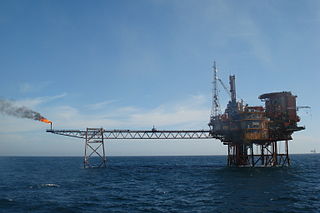Related Research Articles
This is a list of oil and gas fields operated by BP.
The Indefatigable gas field is a large natural gas and associated condensate field located under the North Sea 60 miles off the Norfolk coast.
The Hewett gas field is a large natural gas and associated condensate field located under the North Sea 19 miles off the Norfolk coast.
The West Sole gas field is a natural gas and associated condensate field located under the North Sea 44 miles off the East Yorkshire coast. The field produced Britain’s first offshore natural gas in 1967.
The Viking gas field is a group of natural gas and associated condensate fields located under the southern North Sea about 85 miles from the Lincolnshire coast. The field was in production from 1972 to 2018.
Helder, Helm and Hoorn are adjacent oil fields located in the Netherlands sector of the North Sea 40 km west of Den Helder and 80 km north west of Amsterdam.
The Kotter and Logger oil and gas fields are mid-size fields located in the Netherlands sector of the North Sea, about 40 km west of Den Helder and 107 km north west of Amsterdam. The Kotter and Logger oil fields produced oil from 1984/5 to 2015.
The Schredeneck-See oil field was a significant oil field in the German sector of the Baltic Sea. It was the first oil field in the Baltic, and was Germany’s first offshore oil field. lt produced oil from 1984 until 2000.
The L4-L7 gas fields are significant natural gas producing fields in the Netherlands sectors L4 and L7 of the North Sea. They are operationally one complex which started producing gas from the L7 main platform hub in 1977 and was still partly operational in 2021.

The Montrose oil field is a significant crude oil producing field in the UK sector of the central North Sea, 210 km east of Aberdeen. Production of oil started in 1976 and a major upgrade in 2016 extended the field life to beyond 2030.
The Heather oil field is a significant crude oil producing field in the UK sector of the northern North Sea, 458 km north-north-east of Aberdeen. Production of oil started in 1978 and ceased in 2019, the Heather Alpha installation is currently (2021) undergoing decommissioning.
The Tartan oil field is a significant crude oil producing field in the UK sector of the North Sea, 187 km north-east of Aberdeen. Production of oil started in 1981 and ceased in 2020, the Tartan Alpha installation is currently (2021) undergoing decommissioning.
The Maureen oil field is a partially depleted crude oil field in the UK sector of the central North Sea, 262 km north-east of Aberdeen. Oil was produced from the field reservoir by the Maureen A platform between 1983 and 1999. Proposals to further exploit the residual hydrocarbons in the field have yet to be implemented.
Esmond, Forbes and Gordon are three adjacent, now depleted, natural gas fields in the southern North Sea, 170 km east of Teesside.
The K13 gas fields were major natural gas producing fields in the Netherlands sector of the North Sea, about 130 km west of Den Helder. The fields started producing gas in 1975 but are no longer operational except for one installation used as a riser platform.
The K7-K12 gas fields are significant natural gas producing areas in the Netherlands sector of the North Sea, about 130 km west of Den Helder. These six contiguous fields started producing gas in 1978 and are mostly still operational in 2021.
The K14-K18 gas fields are significant natural gas producing areas in the Netherlands sector of the North Sea, about 120 km north west of Den Helder. These five contiguous fields started producing gas in 1977 and are still operational.
The Planets gas fields are small natural gas producing areas in the UK sector of the southern North Sea, their names are associated with the planets and moons of the solar system. The fields started gas production from 1995, although some have now (2021) ceased operation.
The Minke, Orca, Sillimanite and Wingate fields are natural gas reservoirs and gas production facilities in the southern North Sea; they are close to, or straddle, the United Kingdom / Netherlands median line. Natural gas, which is routed to the Netherlands, has been produced from the fields since 2007.
The York gas field is a natural gas reservoir and production facility in the UK sector of the southern North Sea, about 34 km of east of the Yorkshire coast. It has been in production since March 2013.
References
- ↑ Department of Trade and Industry (1994). The Energy Report. London: HMSO. pp. Map 3. ISBN 0115153802.
- 1 2 3 4 Oilfield Publications Limited (1985). The North Sea Platform Guide. Ledbury UK: Oilfield Publications Limited. pp. 434–53.
- ↑ "Fact sheet L10-6" (PDF). Retrieved 8 October 2021.
{{cite web}}: CS1 maint: url-status (link) - 1 2 "Dutch Offshore Gas: a success story". wur.nl. Retrieved 8 October 2021.
{{cite web}}: CS1 maint: url-status (link) - 1 2 "L10 and L11a gas fields". abarrelfull. Retrieved 8 October 2021.
{{cite web}}: CS1 maint: url-status (link) - ↑ "Neptune energy Our activities Activities". NeptuneEnergy.com. Retrieved 8 October 2021.
{{cite web}}: CS1 maint: url-status (link) - ↑ "Neptune decommissions three platforms in Dutch North Sea". offshore-energy.biz. Retrieved 8 October 2021.
{{cite web}}: CS1 maint: url-status (link) - ↑ "Neptune to conduct Dutch North Sea CCS feasibility study" . Retrieved 8 October 2021.
{{cite web}}: CS1 maint: url-status (link)